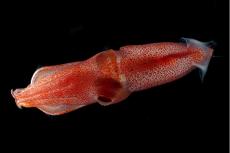The squid with the mismatched eyes—but why?
When it comes to looking for prey, the cockeyed squid (Histioteuthis heteropsis) pretty much has the best of both worlds. With one normally sized eye and the other eye that's much larger and bulges out of its socket, the squid admittedly looks rather strange.
Also known as the strawberry squid, they live in the mesopelagic or twilight zone of the ocean, some 200 to 1,000 metres below the surface. They drift through the sea in a near-vertical orientation, with its head “pointed” downwards, with its larger eye directed slightly upwards and its smaller eye directed slightly downwards.
It turns out that their mismatched eyes is actually an ingenious hunting strategy.
This was what Duke University biologist Kate Thomas discovered when she started investigating the purpose of the mismatched eyes. So she reviewed more than 150 videos of cockney squids collected by the Monterey Bay Aquarium Research Institute.
It was then she realised that the squid's eyes had evolved to its present state so as to take advantage of the two different sources of light available in the deep sea, where the squid lives: The large eye is adapted for gazing upwards, looking for the shadows of animals against the sunlight. The small eye, on the other hand, gazes slightly downwards looking for flashes of bioluminescence.
A paper about the discovery was published in the recent issue of Philosophical Transactions B journal.
“The deep sea is an amazing natural laboratory for eye design, because the kinds of eyes you need to see bioluminescence are different from the kinds of eyes you need to see the basic ambient light," said senior author Sönke Johnsen, Professor of Biology at the university.
"The eye looking down really only can look for bioluminescence. There is no way it is able to pick out shapes against the ambient light. And once it is looking for bioluminescence, it doesn't really need to be particularly big, so it can actually shrivel up a little bit over generations. But the eye looking up actually does benefit from getting a bit bigger," he added.



